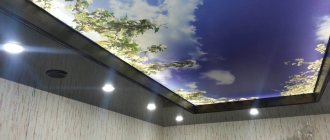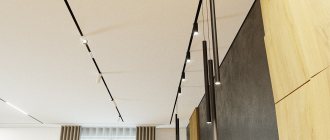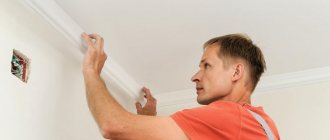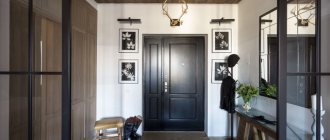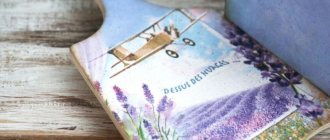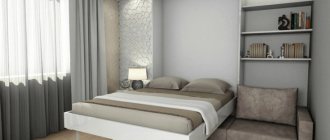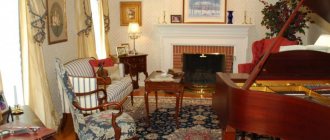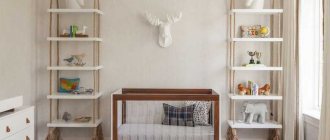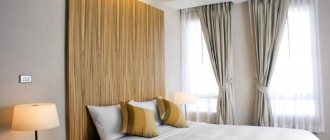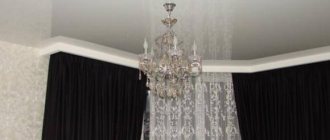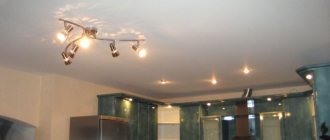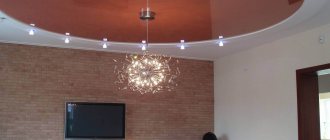A ceiling structure with a transition of levels is an excellent solution for accentuating different styles in the interior. Two-level ceilings allow you to transform a room and divide it into zones. However, not all designers and experts speak out in support of multi-level models; some categorically do not perceive them, considering them a relic of the past, others prove their importance and feasibility.
Special attention has always been paid to the structural element. Architects have long created multi-tiered ceilings. This is easy to prove; just look at the surviving monuments of archeology and architecture. But such pleasure became available to the general public only with the development of scientific and technological progress. Now everyone can afford to decorate their home beautifully.
Features: pros and cons of two-level ceilings
Two-level structures allow you to create two heights within one room. The main feature is the presence of a pronounced step on the ceiling. Ceiling systems simultaneously solve several problems - aesthetic, functional. They are also the main advantages of this coating.
The aesthetic function has a strong emotional impact on a person. This is achieved:
- the presence of two tiers that create visual volume;
- the use of built-in and pendant lamps, decorative lighting;
- complex curvilinear, strict straight forms;
- by using different colors and textures, the design can fit into any style;
- attractive appearance of a perfectly flat surface.
Functional:
- the coating allows you to hide engineering and technical communications;
- makes it possible to easily access the inter-ceiling space;
- increases sound insulation, creates a good acoustic environment in the room;
- allows you to zoning the room;
- hides unevenness of the ceiling partition;
- increases the service life of the ceiling itself.
The disadvantages of the coating include the following:
- reducing the height of the room by 10-15 cm;
- low resistance to mechanical damage of the materials used;
- high price;
- complex installation that not everyone can do with their own hands.
Depending on the chosen configuration, two-level structures can visually raise or lower the ceiling. But for ceilings that are too low, you should still refuse to choose such a finish.
What materials are they made from?
Two-level systems allow you to connect several rooms of a living space into a single ensemble. Make a smooth transition from the living room to the dining room, from the hallway to the kitchen. The structure consists of a profile frame and cladding. The following types of raw materials are used for work:
- drywall;
- stretch fabrics made of fabric or polyvinyl chloride;
- PVC panels (plastic);
- lining;
- combine different materials.
Each of these types has its own distinctive features and is characterized by certain qualities. To understand all the nuances, let's look at each type in more detail. Let's look at their strengths and weaknesses.
Drywall
Drywall can be safely called a classic building material used to create multi-level structures. It is a multilayer sheet consisting of a core (gypsum with filler) covered on both sides with cardboard. Invented in the second half of the 19th century by American businessman Augustine Sackett. Patented May 22, 1884.
The material is installed on a metal profile frame. Ceiling plasterboard is used for work. The lightweight sheet has a thickness of 6-9.5 mm, has good flexibility, and is suitable for creating complex geometric shapes. When installing the first tier, sheets with a thickness of 8-9.5 mm are used, the second - 6 mm (arched gypsum board).
Experts do not recommend using drywall in the kitchen and bathroom. This is due to its ability to absorb moisture and odors. Excessive humidity is unacceptable; under its influence it swells and becomes deformed. But, if desired, you can use special models GKLV (moisture-resistant) and GKLVO (moisture-, fire-resistant).
The advantages of this material include:
- allows you to level any surface;
- with its help they organize the most complex lighting systems;
- under it you can make additional insulation and sound insulation;
- simple structures can be installed with your own hands;
- It bends well, it is possible to make any shapes and bends.
Flaws:
- Cracks appear at the joints over time;
- it has a decent weight, you will need an assistant to complete the work;
- low moisture resistance;
- fragility, fear of mechanical damage.
Stretch ceilings made of PVC and fabric
A stretch ceiling combines two different technologies, which differ depending on the material used: shrink film made of polyvinyl chloride, seamless fabric. The first prototypes of this covering have been known since the times of Ancient Rome, where ceilings were draped with fabric. They began to be used in their usual form since the invention of PVC film; they became widespread in the 60s in Western Europe.
PVC can be called a decorative type of finishing; the fabric’s characteristics are not inferior to plasterboard, and is located in the same niche with it. In addition to the name, both types have one more common characteristic feature - the principle of fastening. The set of both designs includes a baguette (ceiling, wall) and canvas. Let's look at each type separately:
- Fabric. They are a fabric made from polyester thread. The textiles are impregnated with a special mixture based on polyurethane. The finished product is produced in rolls, 5 m wide. The raw materials are characterized by a long service life, low weight, it does not emit harmful substances, and is safe for human health. However, the cost of the product is quite high, and when flooded, the textiles do not hold back water.
- Polyvinyl chloride. The basis of the synthetic material is chlorine and petroleum products. With its help you can get a perfectly flat surface, it is elastic, durable, and waterproof. When exposed to high temperatures, it releases harmful substances into the air.
It is necessary to install a polyvinyl chloride covering only if there is good ventilation. Due to the airtightness, liquids remaining after leaks from above will lead to the appearance of mold and a musty smell.
PVC panels
Plastic panels are made from solid polyvinyl chloride by extrusion. They are lamellas. Their parameters can vary within the following limits: length 2600 - 3000 mm, thickness - 5-10 mm, width - 100-500 mm. They have a lattice structure. The surface is glossy or matte, available in a full range of colors. They appeared on the market in the 90s of the 20th century and quickly became popular.
In rooms with low ceilings, it is better to install products with a glossy surface in light shades. They allow you to make the ceiling visually higher. The dark ones will land him. When creating a two-tier system, different colors are used. Panels with a highlighted seam look good in a bathroom or bathroom. For other rooms, it is recommended to use seamless options and use wide elements in the work.
The advantages of the material include:
- light weight;
- low cost;
- moisture resistance;
- neutrality to microorganisms;
- durability;
- large selection of shades;
- sound and thermal insulation.
Flaws:
- low strength;
- do not retain water during flooding;
- with a sharp change in temperature, the raw material is deformed;
- presence of seams.
Lining
The product is represented by a thin cladding board. The elements are connected using a tongue-and-groove system. Can be mounted on a wooden or metal frame. Made from natural wood, plastic, MDF. The name appeared during a period of technological progress, when railway transport played an important role. For convenience, passenger cars were lined with small planks.
Plastic models are made from polyvinyl chloride mass by extrusion. They have a honeycomb structure and are characterized by the following positive qualities: durability, moisture resistance, low cost, do not require additional processing, and do not fade.
MDF lining is an alternative to wooden and plastic options. It is produced by pressing dry shavings. During operation, the material does not emit harmful substances, so it can be used for children's rooms, bedrooms, and living rooms.
Natural wood is the most common type. It has a natural pattern, is characterized by durability; with special treatment, the service life can reach 15-20 years. Like any wood, it is afraid of moisture and high temperatures.
Combined options
Any person, looking at the combined ceiling, will understand how attractive it looks and transforms the space. This type of finishing is quite in demand. You can do this in several ways:
- Within one type of cladding. By combining pieces of the same raw material of different colors and textures, you can make a smooth transition from one tier to another.
- Connection of fabric and film stretch fabric on one surface. By using different materials, united by one name, a unique design is created. The upper film level with photo printing, surrounded by textile fabric, will make the interior unforgettable.
- Combination of plasterboard and suspended ceilings. By combining various elements, the overall frame is strengthened. There is a wide variety of combinations of these materials:
- A plasterboard structure is installed around the perimeter of the ceiling surface, textiles are stretched inside;
- a protruding or recessed circle in the center of the room, covered with film and vice versa;
- longitudinal, diagonal division by various types of finishing.
Wallpaper
Let's look at some types of wallpaper suitable for ceilings.
Paper, vinyl, non-woven and textile
Paper wallpaper is the most budget-friendly. And if the choice falls on them, then it is better to prefer two-layer ones - the image on them can be either flat or convex. Paper is the most environmentally friendly and breathable finishing material, but that’s where its advantages end.
Non-woven wallpaper is divided into two subtypes - completely non-woven and combined. The latter have only a non-woven base, and the outer side can be vinyl or some other.
BY THE WAY. Wallpaper consisting entirely of non-woven fabric can be painted, and more than once.
Vinyl wallpapers are denser, but they are rarely painted. In addition, this type of canvas is not recommended for use in the kitchen - it absorbs odors.
Textile wallpaper looks cozy and presentable, but you should not try to glue it yourself without experience.
ADVICE. If you have to choose between wallpaper and paint, experts advise taking into account the age of the house. New buildings shrink during the first few years and microcracks appear on the surfaces. And good wallpaper can hide them. And it is better to use paint in houses that are more than 5 years old.
If the ceiling is high enough, choose a large wallpaper pattern - then you can examine it in detail
Liquid wallpaper
This material is a dry mixture of textile fibers and cellulose. Before applying to the surface, the mixture is diluted with water. The advantages of liquid wallpaper are the absence of seams and maintainability. If any area is damaged, it can be “patched” with the remaining mixture.
BY THE WAY . The design of fillets—plinths made of foam plastic or other materials—helps to achieve a neat boundary between the ceiling and the wall.
Liquid wallpaper can be tinted yourself if the desired shade is not available for sale.
Ceiling shape
Two-level structures can have a variety of shapes. This point mainly concerns the steps. From the point of view of the relative position of boundaries, there are two main groups: rectilinear and curvilinear. Let's look at each type in more detail:
- Straightforward. The easiest way to organize a ceiling surface. Characterized by straight lines and clear contours. The method is used to organize a strict interior, where it is necessary to emphasize the seriousness, severity, thoroughness of the owner of the house, and his taste preferences.
- Curvilinear. A more complex option. When designing, use smooth, rounded, curved lines. This method allows you to realize different design ideas and create interesting shapes. With their help, they perform zoning of rooms in which it is impossible to install partitions.
- Combined. From a technical point of view, the most difficult type. By combining straight and curved lines, designers create any ideas. The use of lighting allows you to emphasize existing patterns, shapes, and textures.
Stylistic direction
All existing interior design styles can be combined into three main groups: modern, classic, ethnic. In any of them you can create a two-level system. The use of matte, glossy, mirror finishing materials, a combination of smooth and strict lines, and play with light will allow you to design the room in any direction. For clarity, let’s look at several popular design options:
- Classic. Regular geometric shapes and symmetry are welcome. Several light sources are used on the ceiling; along with the central chandelier, spotlights are placed around the perimeter. Tension structures made of light-colored textiles will fit perfectly. White, yellow, gold, beige colors are suitable, in some cases it is appropriate to use black.
- Greek. A good option for a home with high ceilings. You can use shades of the same color on different tiers. White, lemon, walnut, and cornflower blue backgrounds are welcome. There should be moderation in everything; a stucco ribbon will look great on the transition lines.
- Rustic. A mix of American country with Russian izba. Natural, natural materials are used here. A surface covered with clapboard made of natural wood will look great in this style.
- Minimalism. The lines on the ceiling are straight. The forms are strict. White color. You can use one chandelier in the center; often there are no lamps at all; they are placed on the walls. Painted plasterboard structures are suitable.
Texture
Polystyrene foam and drywall are simply matte and that’s all - at most, they can be painted in different colors or made similar to a wooden or stone surface using the appropriate color scheme. With stretch ceilings everything is much more interesting.
They can be:
- Smooth. A bright mirror surface of any color is the classic film ceiling that everyone is used to. It reflects everything that happens below, makes the room visually larger, expands the space and looks impressive.
- Regular matte fabric. The texture is similar to plaster and looks about the same. You can paint it, you can leave it as is. If left, it will make the room both larger and cozier - the matte texture is more pleasing to the eye.
- Matte satin. Satin is also white, but it is distinguished by a specific shine that looks especially impressive if you add some paint on top. A beautiful solution with a pearlescent tint will also visually enlarge the room.
- Artistic painting. It can only be done on fabric, and if you find a good professional artist, it will look like in a real art gallery. It could be a geometric pattern, it could be a floral pattern, or it could be a real painting - it is best to place it surrounded by a bright glossy surface.
- Photo printing. A variant of the artistic approach, but simpler than painting. It is usually made to order, it can be done either on a glossy surface - then it will be bright, colorful - or on a matte surface, then it will be muted. There are ready-made paintings that can be purchased without prior ordering.
The main thing is to choose well, since it will not suit every interior.
- Starry sky. Made using satin, small lamps are placed behind the ceiling to imitate the glow of stars. A very beautiful, cosmic solution that is suitable for a living room made in dark colors.
- Metallic shine. Suitable for high-tech style, done on film. It can be silver, steel, gold, bronze - the main thing is that it matches the main interior. Variety - mirror shine. It does not allow you to completely imitate a mirror, but it turns out somewhat similar.
You can always combine several textures instead of making a two-level ceiling monochromatic.
You can, for example, make a drawing using painting on a fabric insert in the middle, and cover the rest of the ceiling with a glossy film. Or imitate the surface of the sky using photo printing and make cloud inserts from plasterboard.
The main thing is in the process of coming up with a design to correlate your ideas with the technical capabilities, as well as with the rest of the interior of the room.
Color spectrum
Each color evokes certain emotions in a person and has a psychological effect on him. The right shade will help you relax, feel cozy and comfortable, so choosing a suitable background must be done in advance. If you make a mistake in color design, you can end up with a room that will irritate and cause a feeling of depression.
The classic tone for the ceiling is white. It can be combined with any other color from the entire palette. It evokes bright associations and is a sign of novelty and purity. This coating is suitable for any room. However, in its pure form it can look quite boring; it should be diluted with other shades.
To decorate living rooms, a blue tone is often used. For example, they make combined structures where the drywall is painted light and the tension fabric is painted purple. Blue color can be used when arranging a toilet, bathroom, blue in small quantities - for a bedroom, children's room, purple - in the living room. You can use red and orange in the kitchen or office. They excite and stimulate mental activity.
A color scheme
The use of two-level suspended ceilings implies certain rules for color combinations, because each individual level will have a different color. But you should remember that there are no absolute rules in design, so violating them is welcome, as long as you personally like the final result. But understanding the basic principles will definitely be useful, so we offer you a convenient table.
The palette is quite multifaceted, but if necessary, a two-level design can be done in one color, just in different shades, so that everything does not merge into one inexpressive composition. This technique does not in any way violate the integrity of the idea and gives the room a certain organization. It is important to know that all types of color are conventionally divided into several ranges: neutral, pastel, natural, dynamic, dark.
The most common are light (neutral) shades, which bring positivity and make the room airy, filling it with lightness. If you add dark color here, the perception will be completely different, not so cheerful. To do this, you need to add several live (color) shades that will give the desired effect.
Pastel colors look good when you need to create two rows of fabric that fit together. They pair perfectly with white and add coziness to any room. But first of all, you need to build on the general concept of the interior, as well as the furnishings of the room and all its elements.
When using natural (natural) colors, it is important that these are fairly bright, expressive shades that should not coincide with the tone of the furniture. If you use bright colors, then do it in doses, diluting it with white (light) shades. When dominance of one color occurs, an imbalance occurs. It is best to use lilac, violet, yellow, burgundy and wine. More difficult to combine are blue, bronze and orange.
Rules for lighting and decorative lighting
Two-level ceilings can transform any room. The design itself looks very original, and if it is supplemented with lighting fixtures and decorative lighting, it will become an accent of the interior. There are many ways to do lighting. For this you can use:
- Chandelier. Usually they use one large product and place it in the center of the ceiling structure.
- Spotlights. They can be used on any ceilings. Used to illuminate a specific area.
- Fluorescent lamps. Economical and durable. Gives warm natural, cool white light.
For decorative lighting use:
- LED strips. Very flexible. The entire level is illuminated around the perimeter. Using the controller, you can change the hue and intensity of the light.
- Flexible neon. It differs from the previous version in that light is emitted in all directions.
- LED duralight. A beautiful and functional addition to any ceiling structure. Unlike an LED strip, the diodes are contained in a plastic tube.
- Fiber optic luminaires. Provides a beautiful shimmer and highlights the texture of the finish.
Photo gallery (30 photos)
Vinyl fabric Textile fabric
Glossy ceiling
Matte ceilings
Satin ceiling
- How to heat the ceiling sheet
- Film heating guns
- Satin stretch ceiling, its pros and cons, photo ideas
Application examples in different rooms
Thanks to the mounting features, two-level ceilings can be installed in small rooms. The soft, hard fabric will be attached just a few centimeters from the ceiling, which will allow installation with virtually no loss of room height. The freedom to choose the type of canvas can only be limited by the sizes and models of lamps. A wide variety of modern ceiling materials allows you to assemble a structure even in rooms whose area previously did not allow this.
In the living room
Typically, in a spacious room, two-level ceilings are used to zone the space. A low part of the ceiling is placed above the seating area with a sofa and TV. This could be near a wall or in the center of the living room. Working or dining areas indicate high areas. This method of separation is suitable for large rooms; in other cases it is better to use furniture and partitions.
In living room interiors, curved plasterboard ceilings are often found. Smooth, illuminated lines create the impression of space dynamism and fluidity. This effect should be supported by the layout and color dynamics. With the help of a two-level ceiling, you can change the geometry of the living room and create a certain mood in the common room.
In the kitchen
The tradition of decorating the ceiling in several levels was still in the royal dining chambers. The main advantage of such structures is the reliable masking of communications, irregularities, surface roughness, beams and wires running along the ceiling.
Using a two-level ceiling, the kitchen space is divided into a work area and a place for relaxation and eating. The lowest part of the structure is located above the dining table. This makes it possible to use maximum lighting and decorate the surface with lighting fixtures of any type. The countertop, sink, stove and refrigerator are placed in an area without ceiling lighting. The lighting built into the set and hood will be sufficient for the work surfaces.
Ceiling structures in several tiers can be made straight or curly. Smooth lines, circles, ovals allow you to decorate a small kitchen with laconic lamps. Intermediate voids and bulges can be highlighted with color. A combination of red and beige, sand and pistachio will look harmonious.
In the bedroom
In the recreation room, the two-tier ceiling plays a decorative role. It is the first thing that catches your eye when you wake up and the last one that leads you to sleep. Thanks to the design, you can use lighting of varying intensity, create beautiful relief and unimaginable lines. A beautiful chandelier is placed in the center on a large platform; LEDs can be placed around the perimeter. Illumination with smooth, soft transitions creates a romantic mood.
Multi-level ceilings suppress noise well and allow you to avoid focusing on uneven surfaces. A mirror surface in several tiers, mounted on a metal frame, will look great in the bedroom. This technique visually expands the boundaries of the room, fills the bedroom with light, makes it voluminous and spacious.
Combined level ceilings look good in the bedroom. When choosing a design, the flight of imagination is unlimited. You can combine wood and drywall, textiles and PVC. Tiers of high ceilings can be decorated with stucco and a “starry sky” projection can be made.
In the hallway and corridor
In a room with a small area, finishing technology is much easier to master. The ceilings in the hallway can be literally transformed by making them into two tiers. You can combine drywall and PVC film. Such designs visually raise the ceilings and make it possible to install tall wardrobes without the risk of damaging the fabric.
The most common way to arrange a ceiling in two tiers is to construct a frame around the perimeter of the hallway, which descends a few centimeters below the main covering. The original edging can be smooth, embossed, of any width and size. Side boxes are usually used for mounting lamps. Thus, the main fabric remains intact, without dents or punctures.
An interesting texture or pattern can be obtained by covering plasterboard structures with PVC film. All kinds of designs are applied to the elastic vinyl coating. It could be a copy of a famous painting, a mosaic, an imitation of a fresco. A bold design move for the hallway is perforation. The top layer of multi-level material is visible through the holes of the bottom one.
In the children's room
The easiest way to decorate a ceiling in a nursery is to combine two colors. These can be shades of the same tone or a contrasting bright combination. The play area is highlighted with a brighter color, the relaxation area and the area above the work desk are decorated with a calm color.
One of the ceiling tiers in the children's room can be decorated with drawings. When choosing a full-fledged picture, it is necessary to take into account the child’s age, interests, and preferences. For babies under one year old, an image of nature in muted pastel colors is suitable. Younger schoolchildren and preschoolers will look at the characters of their favorite cartoons with interest.
Multi-level ceilings in a nursery with an age-appropriate print should not be durable, as the child will grow up and lose interest in the picture. In a teenage room, the ceiling should match the overall style of the room.
From the floor to the top
Conventional flooring can also end up on other planes. Among such universals, the first places are occupied by laminate and cork.
Laminate
There is no special ceiling laminate - the same one used for the floor is used. At the same time, you can safely choose not the most durable types, because the load on it will be small.
Preference is given to the lightest colors - white, grayish, yellowish and beige. The wood-imitating coating has shades such as white oak, light walnut and ash. In tall and well-lit rooms, you can safely use dark colors.
ADVICE. There is no need to use the same shade of laminate both below and above - such an interior will turn out to be too monotonous and flat.
Laminate can also imitate metal, stone, concrete and other materials. And, if “wood” is suitable for a modern style, then “metal” will look great in a high-tech interior, “stone” in a Gothic setting, and “concrete” in a loft.
Laminate flooring on a high ceiling can easily be confused with natural wood
Cork tree
Another option for finishing the ceiling is to use balsa wood. This material has the following advantages:
- environmental friendliness;
- variety of shades;
- thermal insulation;
- soundproofing;
- small thickness;
- the ability to bend panels in order to trim various protrusions with them;
- resistance to fungus;
- water resistance.
One of the disadvantages is that the cork must be coated with wax or varnish. This material is difficult to work with and there is a risk of damaging it during installation. Therefore, it is impossible to do without professionals.
This cork ceiling is especially good for living rooms
DIY two-level plasterboard ceiling
Installing a ceiling of several levels is a labor-intensive process. With proper organization of work and the correct selection of materials and tools, you can make a ceiling structure yourself with minimal financial and time losses. To do this, you need to be patient and follow the detailed instructions step by step.
Materials and tools
To install a plasterboard structure, you will need to stock up on a large number of consumables. In addition to the basic sheets of drywall, materials for the construction of the frame and finishing coating will be needed to create the levels. Here is a complete list of tools that will definitely come in handy:
- Construction knife;
- Screwdriver Set;
- Profile cutter;
- Metal scissors;
- Laser level;
- Rule;
- Screwdriver with drill;
- Safety glasses and gloves;
- Set of spatulas;
- Hammer;
- Ladder;
- Painting thread.
Drafting
Drawing up a correct and detailed drawing is one of the most important points at the design stage. It is necessary to calculate in advance the amount of materials required for the work and the associated financial costs. Having chosen a suitable design, they move on to a schematic reflection of the suspended ceiling. The maximum level to which the frame can be lowered, the type and number of lamps are determined.
If one of the tiers of the ceiling has curves, it is necessary to calculate their radii. Also, the plan for future work must include a detailed diagram of the location of communications and engineering systems from the following points:
- Location of distribution boxes;
- Type of electrical wiring, cross-section, cable length;
- Features of connecting lamps, location of switches, controllers;
- Placement of hood, air duct.
Surface preparation
Before starting work, it is necessary to prepare the room. It is necessary, if possible, to free him from furniture. You will also need to remove curtains and remove carpets. Whitewash and old peeling plaster should be washed off from the ceiling. Acceptable conditions must be created for cutting and installing drywall, since the material does not tolerate excessive moisture and temperature changes.
Wires for future lamps must be brought out and the mounting locations for lamps and chandeliers must be marked. The ceiling surface does not have to be flat; all defects will be hidden under a box of durable material.
Ceiling marking and profile installation
Markings are applied to the prepared surfaces according to the previously made drawing. For this, use a laser level and a simple pencil. First you need to build a regular rectangle, measure the size of the first and second levels. The location of all load-bearing profiles is transferred to the ceiling slab, and a grid is built for the convenience of further work.
Installation of the profile must be carried out strictly in stages. Suspensions are attached in designated places. Then a guide profile is installed, covered with sealing tape and fixed to the wall. Now the remaining parts are screwed from the corners to the center.
For curly multi-tiered ceilings, a curved profile will be required. He needs to be given the right direction on his own. The material is cut with metal scissors every 10 cm and bent according to the planned pattern.
Electrical wiring and lighting rules
Properly chosen lighting will not only create a cozy, comfortable environment, but will also make smart accents on selected interior items. It is necessary to take care of the location of the lamps at the stage of surface preparation and profile installation.
Even before the sheathing begins, holes are made in the plasterboard sheets. If a chandelier is chosen, it should not be pompous. A structure with several levels will look attractive in itself. A lamp with a large number of decorative elements can overload the suspended ceiling.
Spotlights are often used to organize lighting for two-level tiered ceilings. You can mount rotating or non-rotating devices. In the first case, more possibilities and variations with devices open up. There are many models of lampshades of different colors, shapes, sizes (2 x 2, 5 x 5). The device is selected based on the overall interior of the room.
Cutting, installation and rough finishing of drywall
Cut the drywall according to the preliminary mark. First, a knife is drawn along the line under the ruler with force to drive the blade 2-3 mm, then part of the element is broken off. To obtain a smooth edge, the cardboard on the other side is cut and the cut area is cleaned with sandpaper.
Before mounting the prepared rectangular sheet to the frame, chamfers are removed. The edges are cut at an angle to better fill the cracks with putty. Begin to fasten the elements from the corners, keeping the distance between the screws no more than 20 cm.
To screw a piece of drywall to a round structure, the prepared element must first be softened. To do this, small holes are made in it with a needle roller and sprinkled with water. After 30 minutes, the workpiece becomes more pliable and can be given any arched shape. Installation must be done while the drywall remains damp.
Options and ideas for finishing
The initial stage of finishing is puttingty of all joints and seams between the fixed sheets of drywall. The starting mixture is used to fill the recesses, places where screws are screwed in, and crevices, reinforced with paper tape and allowed to dry. Then, to level it, sand it with sandpaper. Then the entire surface of the box is covered with finishing putty.
Standard finishes can be enhanced to create a more interesting result. The finishing mixture is combined with painting. You will get an unusual result if you apply the colored composition to the putty in several layers. You can also use wallpaper and textured plaster.
